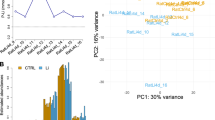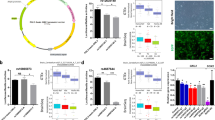Abstract
To identify genes dysregulated in bipolar disorder (BD1), we carried out global gene expression profiling using whole-genome microarrays. To minimize genetic variation in gene expression levels between cases and controls, we compared expression profiles in lymphoblastoid cell lines from monozygotic twin pairs discordant for the disease. We identified 82 genes that were differentially expressed by ⩾1.3-fold in three BD1 cases compared to their co-twins, and which were statistically (P⩽0.05) differentially expressed between the groups of BD1 cases and controls. Using quantitative reverse transcriptase-polymerase chain reaction, we confirmed the differential expression of some of these genes, including: KCNK1, MAL, PFN2, TCF7, PGK1 and PI4KCB, in at least two of the twin pairs. In contrast to the findings of a previous study by Kakiuchi and colleagues with similar discordant BD1 twin design, our data do not support the dysregulation of XBP1 and HSPA5. From pathway and gene ontology analysis, we identified upregulation of the WNT signalling pathway and the biological process of apoptosis. The differentially regulated genes and pathways identified in this study may provide insights into the biology of BD1.
This is a preview of subscription content, access via your institution
Access options
Subscribe to this journal
Receive 12 print issues and online access
$259.00 per year
only $21.58 per issue
Buy this article
- Purchase on Springer Link
- Instant access to full article PDF
Prices may be subject to local taxes which are calculated during checkout

Similar content being viewed by others
Accession codes
References
Kakiuchi C, Iwamoto K, Ishiwata M, Bundo M, Kasahara T, Kusumi I et al. Impaired feedback regulation of XBP1 as a genetic risk factor for bipolar disorder. Nat Genet 2003; 35: 171–175.
Bertelsen A, Harvald B, Hauge M . A Danish twin study of manic-depressive disorders. Br J Psychiatry 1977; 130: 330–351.
Kieseppa T, Partonen T, Haukka J, Kaprio J, Lonnqvist J . High concordance of bipolar I disorder in a nationwide sample of twins. Am J Psychiatry 2004; 161: 1814–1821.
McGuffin P, Rijsdijk F, Andrew M, Sham P, Katz R, Cardno A . The heritability of bipolar affective disorder and the genetic relationship to unipolar depression. Arch Gen Psychiatry 2003; 60: 497–502.
Marcotte ER, Srivastava LK, Quirion R . cDNA microarray and proteomic approaches in the study of brain diseases: focus on schizophrenia and Alzheimer's disease. Pharmacol Ther 2003; 100: 63–74.
Middleton FA, Pato CN, Gentile KL, McGann L, Brown AM, Trauzzi M et al. Gene expression analysis of peripheral blood leukocytes from discordant sib-pairs with schizophrenia and bipolar disorder reveals points of convergence between genetic and functional genomic approaches. Am J Med Genet B Neuropsychiatr Genet 2005; 136: 12–25.
Segman RH, Shefi N, Goltser-Dubner T, Friedman N, Kaminski N, Shalev AY . Peripheral blood mononuclear cell gene expression profiles identify emergent post-traumatic stress disorder among trauma survivors. Mol Psychiatry 2005; 10: 500–513, 425.
Tsuang MT, Nossova N, Yager T, Tsuang MM, Guo SC, Shyu KG et al. Assessing the validity of blood-based gene expression profiles for the classification of schizophrenia and bipolar disorder: a preliminary report. Am J Med Genet B Neuropsychiatr Genet 2005; 133: 1–5.
Vawter MP, Ferran E, Galke B, Cooper K, Bunney WE, Byerley W . Microarray screening of lymphocyte gene expression differences in a multiplex schizophrenia pedigree. Schizophr Res 2004; 67: 41–52.
McCurdy RD, Feron F, Perry C, Chant DC, McLean D, Matigian N et al. Cell cycle alterations in biopsied olfactory neuroepithelium in schizophrenia and bipolar I disorder using cell culture and gene expression analyses. 2006; 80: 163–175.
Sullivan PF, Fan C, Perou CM . Evaluating the comparability of gene expression in blood and brain. Am J Med Genet B Neuropsychiatr Genet 2006; 141: 261–268.
Feron F, Perry C, Hirning MH, McGrath J, Mackay-Sim A . Altered adhesion, proliferation and death in neural cultures from adults with schizophrenia. Schizophr Res 1999; 40: 211–218.
Mahadik SP, Mukherjee S . Cultured skin fibroblasts as a cell model for investigating schizophrenia. J Psychiatr Res 1996; 30: 421–439.
Perl O, Ilani T, Strous RD, Lapidus R, Fuchs S . The alpha7 nicotinic acetylcholine receptor in schizophrenia: decreased mRNA levels in peripheral blood lymphocytes. FASEB J 2003; 17: 1948–1950.
Petronis A . Human morbid genetics revisited: relevance of epigenetics. Trends Genet 2001; 17: 142–146.
Petronis A, Gottesman II, Kan P, Kennedy JL, Basile VS, Paterson AD et al. Monozygotic twins exhibit numerous epigenetic differences: clues to twin discordance? Schizophr Bull 2003; 29: 169–178.
Kan PX, Popendikyte V, Kaminsky ZA, Yolken RH, Petronis A . Epigenetic studies of genomic retroelements in major psychosis. Schizophr Res 2004; 67: 95–106.
Spector N . Cancer, genes, and the environment. N Engl J Med 2000; 343: 1494, discussion 5–6.
Duffy DL, Martin NG, Battistutta D, Hopper JL, Mathews JD . Genetics of asthma and hay fever in Australian twins. Am Rev Respir Dis 1990; 142 (6 Part 1): 1351–1358.
Whitney AR, Diehn M, Popper SJ, Alizadeh AA, Boldrick JC, Relman DA et al. Individuality and variation in gene expression patterns in human blood. Proc Natl Acad Sci USA 2003; 100: 1896–1901.
Radich JP, Mao M, Stepaniants S, Biery M, Castle J, Ward T et al. Individual-specific variation of gene expression in peripheral blood leukocytes. Genomics 2004; 83: 980–988.
Eady JJ, Wortley GM, Wormstone YM, Hughes JC, Astley SB, Foxall RJ et al. Variation in gene expression profiles of peripheral blood mononuclear cells from healthy volunteers. Physiol Genomics 2005; 22: 402–411.
Cichon S, Buervenich S, Kirov G, Akula N, Dimitrova A, Green E et al. Lack of support for a genetic association of the XBP1 promoter polymorphism with bipolar disorder in probands of European origin. Nat Genet 2004; 36: 783–784.
Association AP . Diagnostic and Statistical Manual of Mental Disorders, 4th edn (DSM-IV). American Psychiatric Press Inc.: Washington, DC, 1994.
Nurnberger Jr JI, Blehar MC, Kaufmann CA, York-Cooler C, Simpson SG, Harkavy-Friedman J et al. Diagnostic interview for genetic studies. Rationale, unique features, and training. NIMH Genetics Initiative. Arch Gen Psychiatry 1994; 51: 849–859.
Gershon ES, DeLisi LE, Hamovit J, Nurnberger Jr JI, Maxwell ME, Schreiber J et al. A controlled family study of chronic psychoses. Schizophrenia and schizoaffective disorder. Arch Gen Psychiatry 1988; 45: 328–336.
Maxwell M . Family Interview for Genetic Studies (FIGS): A Manual for FIGS. Clinical Neurogenetics Branch, Intramural Research Program, National Institute of Mental Health: Bethesda, MD, 1992.
Leckman JF, Sholomskas D, Thompson WD, Belanger A, Weissman MM . Best estimate of lifetime psychiatric diagnosis: a methodological study. Arch Gen Psychiatry 1982; 39: 879–883.
Neitzel H . A routine method for the establishment of permanent growing lymphoblastoid cell lines. Hum Genet 1986; 73: 320–326.
Silicon-Genetics. Cross-gene error model 2002; http://www.silicongenetics.com/Support/GeneSpring/GSnotes/analysis_guides/error_model.pdf.
Dennis Jr G, Sherman BT, Hosack DA, Yang J, Gao W, Lane HC ; et al. DAVID: Database for Annotation, Visualization, and Integrated Discovery. Genome Biol 2003; 4: P3.
Pfaffl MW . A new mathematical model for relative quantification in real-time RT-PCR. Nucleic Acids Res 2001; 29: e45.
Iwamoto K, Kakiuchi C, Bundo M, Ikeda K, Kato T . Molecular characterization of bipolar disorder by comparing gene expression profiles of postmortem brains of major mental disorders. Mol Psychiatry 2004; 9: 406–416.
Hakak Y, Walker JR, Li C, Wong WH, Davis KL, Buxbaum JD et al. Genome-wide expression analysis reveals dysregulation of myelination-related genes in chronic schizophrenia. Proc Natl Acad Sci USA 2001; 98: 4746–4751.
Bezchlibnyk YB, Wang JF, McQueen GM, Young LT . Gene expression differences in bipolar disorder revealed by cDNA array analysis of post-mortem frontal cortex. J Neurochem 2001; 79: 826–834.
Benes FM, Matzilevich D, Burke RE, Walsh J . The expression of proapoptosis genes is increased in bipolar disorder, but not in schizophrenia. Mol Psychiatry 2006; 11: 241–251.
Konradi C . Gene expression microarray studies in polygenic psychiatric disorders: applications and data analysis. Brain Res Brain Res Rev 2005; 50: 142–155.
Iwamoto K, Bundo M, Kato T . Altered expression of mitochondria-related genes in postmortem brains of patients with bipolar disorder or schizophrenia, as revealed by large-scale DNA microarray analysis. Hum Mol Genet 2005; 14: 241–253.
Tkachev D, Mimmack ML, Ryan MM, Wayland M, Freeman T, Jones PB et al. Oligodendrocyte dysfunction in schizophrenia and bipolar disorder. Lancet 2003; 362: 798–805.
Ryan MM, Lockstone HE, Huffaker SJ, Wayland MT, Webster MJ, Bahn S . Gene expression analysis of bipolar disorder reveals downregulation of the ubiquitin cycle and alterations in synaptic genes. 2006; 11: 965–978.
Quiroz JA, Gould TD, Manji HK . MOLECULAR EFFECTS of lithium. Mol Interv 2004; 4: 259–272.
White JH, McIllhinney RA, Wise A, Ciruela F, Chan WY, Emson PC et al. The GABAB receptor interacts directly with the related transcription factors CREB2 and ATFx. Proc Natl Acad Sci USA 2000; 97: 13967–13972.
Morris JA, Kandpal G, Ma L, Austin CP . DISC1 (Disrupted-In-Schizophrenia 1) is a centrosome-associated protein that interacts with MAP1A, MIPT3, ATF4/5 and NUDEL: regulation and loss of interaction with mutation. Hum Mol Genet 2003; 12: 1591–1608.
Fraga MF, Ballestar E, Paz MF, Ropero S, Setien F, Ballestar ML et al. Epigenetic differences arise during the lifetime of monozygotic twins. Proc Natl Acad Sci USA 2005; 102: 10604–10945.
Dallas PB, Gottardo NG, Firth MJ, Beesley AH, Hoffmann K, Terry PA et al. Gene expression levels assessed by oligonucleotide microarray analysis and quantitative real-time RT-PCR – how well do they correlate? BMC Genomics 2005; 6: 59.
Acknowledgements
This work was supported by grants from the Australian National Health and Medical Research Council Grant Number 252777, Ipswich Hospital Foundation and the Rebecca L Cooper Foundation. We are grateful to the twins for their participation in this study and Dr Sandra Pavey for helpful discussions. We sincerely thank Professor Kato and Dr Kakiuchi for providing unpublished data for selected genes from their microarray study of twin pairs discordant for BD1. We also thank the following for their clinical and/or laboratory contribution: Dr Dominique Hannah, Elizabeth Leeton, Lauren Hoiles, Duncan McLean and Deborah Nertney. We are also extremely grateful to Dr Andrew Holloway and Dileepa Diyagama for access to the core microarray facility at the Peter MacCallum Cancer Institute and for valuable input on technical aspects of the array protocol.
Author information
Authors and Affiliations
Corresponding author
Additional information
Supplementary Information accompanies the paper on the Molecular Psychiatry web site (http://www.nature.com/mp)
Rights and permissions
About this article
Cite this article
Matigian, N., Windus, L., Smith, H. et al. Expression profiling in monozygotic twins discordant for bipolar disorder reveals dysregulation of the WNT signalling pathway. Mol Psychiatry 12, 815–825 (2007). https://doi.org/10.1038/sj.mp.4001998
Received:
Revised:
Accepted:
Published:
Issue Date:
DOI: https://doi.org/10.1038/sj.mp.4001998
Keywords
This article is cited by
-
TNIK influence the effects of antipsychotics on Wnt/β-catenin signaling pathway
Psychopharmacology (2021)
-
Intrinsic and extrinsic mechanisms of synapse formation and specificity in C. elegans
Cellular and Molecular Life Sciences (2019)
-
Paternal nicotine exposure defines different behavior in subsequent generation via hyper-methylation of mmu-miR-15b
Scientific Reports (2017)
-
Molecular mechanisms underlying noncoding risk variations in psychiatric genetic studies
Molecular Psychiatry (2017)
-
Identification of a Bipolar Disorder Vulnerable Gene CHDH at 3p21.1
Molecular Neurobiology (2017)



